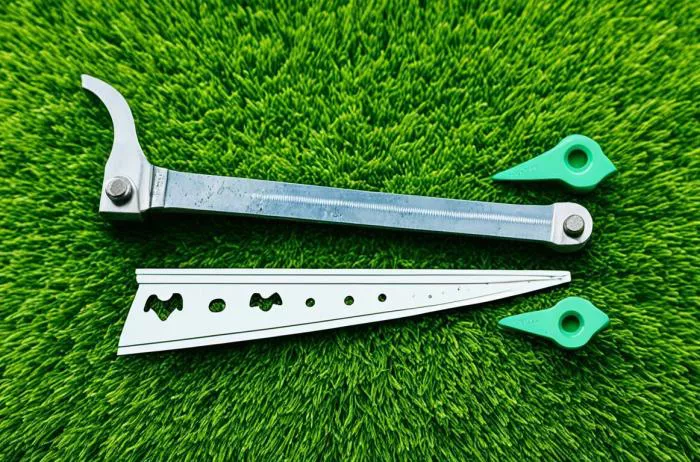Balancing lawn mower blades is essential for maintaining a healthy lawn and extending the life of your mower. Unbalanced blades cause uneven cuts, excessive vibration, and premature wear on the mower’s engine and deck. Star holes, also known as star-shaped center holes, are common in many modern mower blades and require special attention during balancing. This guide will explain how to properly balance lawn mower blades with star holes using professional techniques.
Why Balancing Lawn Mower Blades Is Important?
An unbalanced lawn mower blade creates several problems. First, it leads to uneven grass cutting, leaving patches of taller grass. Second, the vibration from an unbalanced blade strains the mower’s engine, bearings, and spindle, reducing their lifespan. Third, excessive vibration makes the mower harder to control, causing discomfort for the operator.
Balancing the blade ensures smooth operation, reduces wear and tear, and improves cutting performance. Star holes add complexity because they require precise alignment during reinstallation.
Tools Needed for Balancing Lawn Mower Blades
Before starting, gather the necessary tools:
Blade balancer: A specialized tool designed to check blade balance.
Wrench or socket set: For removing and reinstalling the blade.
File or grinder: To remove excess metal if the blade is unbalanced.
Safety gloves and goggles: To protect hands and eyes during the process.
Cleaning brush: To remove grass clippings and debris from the blade.
Step by Step Guide to Balancing Lawn Mower Blades With Star Holes
Removing the Blade
Safety is the top priority. Disconnect the spark plug to prevent accidental engine starts. Tilt the mower carefully, ensuring no fuel or oil leaks. Use a wrench to loosen the bolt holding the blade. Some blades have a star hole that fits a specific spindle design, so note the orientation before removal.
Cleaning the Blade
Grass clippings, dirt, and rust can affect balance. Use a stiff brush to clean both sides of the blade. Inspect for cracks, bends, or excessive wear. If the blade is damaged, replace it instead of balancing.
Checking the Blade Balance
Place the blade on a blade balancer. A balanced blade will sit horizontally. If one side dips, it is heavier. Mark the heavier side with chalk for adjustment.
Grinding the Heavier Side
Use a file or grinder to remove small amounts of metal from the heavier side. Grind evenly along the edge, not the center. Recheck balance frequently. Remove only a little material at a time to avoid overcorrecting.
Reinstalling the Blade
Align the star hole with the spindle correctly. Tighten the bolt securely, but avoid over-tightening, which can damage threads. Reconnect the spark plug and test the mower on a flat surface to ensure smooth operation.
Common Mistakes to Avoid When Balancing Blades
Ignoring blade damage: A bent or cracked blade cannot be balanced safely. Always inspect before attempting to balance.
Over-grinding: Removing too much metal weakens the blade and affects cutting performance.
Incorrect reinstallation: Misaligning the star hole causes imbalance and vibration.
Skipping safety precautions: Always disconnect the spark plug and wear protective gear.
How Often Should You Balance Lawn Mower Blades?
Blades should be balanced every 25 to 30 hours of use or at least once per mowing season. Frequent use on rough terrain may require more frequent checks. Sharpen the blade before balancing to ensure optimal performance.
Additional Tips for Maintaining Lawn Mower Blades
Regular sharpening: Dull blades tear grass instead of cutting cleanly, leading to disease and uneven growth.
Proper storage: Store the mower in a dry place to prevent rust and corrosion.
Using the right blade: Ensure the replacement blade matches the mower’s specifications, including the star hole design.
Understanding Star Hole Blade Designs
Star holes are engineered for better torque transmission and secure mounting. Unlike round holes, they prevent slippage under heavy loads. However, they must be aligned precisely during installation. Some manufacturers use proprietary star patterns, so always check compatibility when replacing blades.
Alternative Balancing Methods
If a blade balancer is unavailable, a simple nail or screwdriver can serve as a makeshift balancer. Hang the blade horizontally—if one side tilts down, it needs grinding. While not as precise as a professional balancer, this method works in a pinch.
Signs Your Blade Needs Balancing
Excessive vibration, uneven cutting, or unusual noises indicate imbalance. If the mower shakes noticeably or leaves ragged grass edges, inspect the blade immediately. Regular maintenance prevents costly repairs and ensures a pristine lawn.
Conclusion
Balancing lawn mower blades with star holes is a crucial maintenance task that improves cutting quality and extends mower life. By following the correct steps and avoiding common mistakes, you can ensure smooth, vibration-free operation. Regular inspection, cleaning, and balancing will keep your lawn looking its best while protecting your equipment.
Always prioritize safety and use the right tools for the job. If unsure, consult a professional for assistance. A well-balanced blade makes mowing easier and more efficient, saving time and effort in the long run.
Related topics:
- HOW TO OPERATE A TROY-BILT RIDING LAWN MOWER
- HOW TO USE YARDWORKS LAWN MOWER: A COMPLETE GUIDE
- WHAT TO LOOK FOR WHEN BUYING A USED LAWN MOWER

